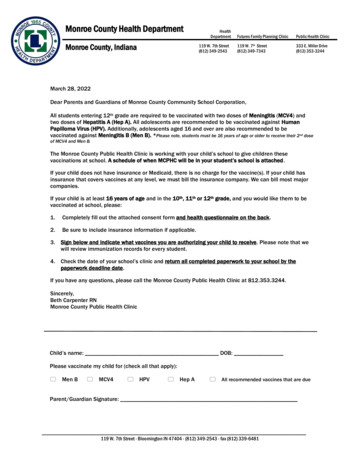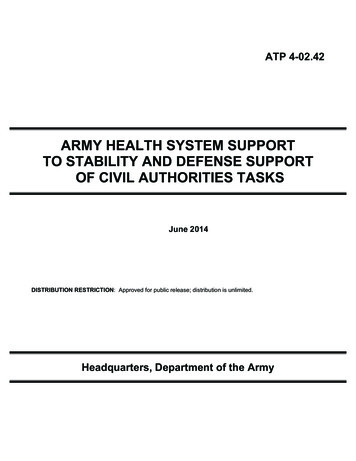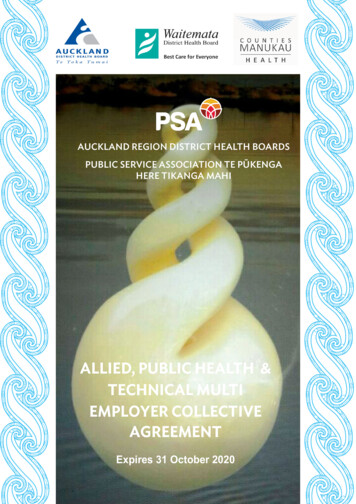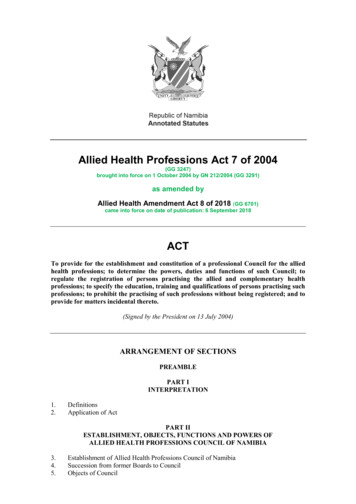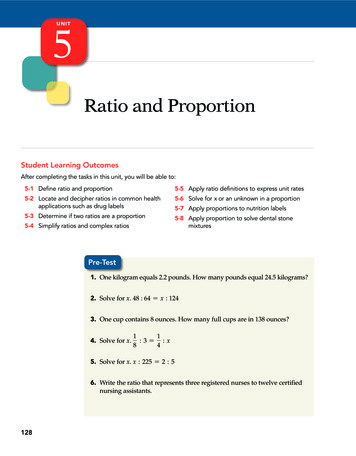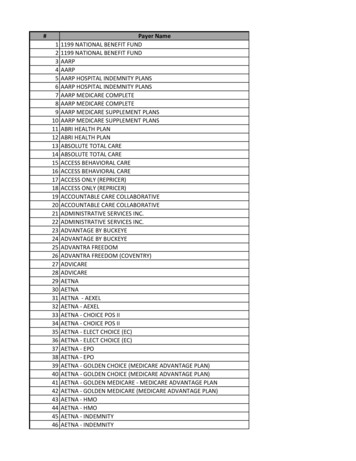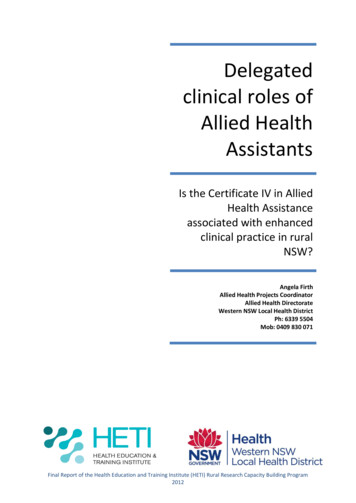
Transcription
Delegatedclinical roles ofAllied HealthAssistantsIs the Certificate IV in AlliedHealth Assistanceassociated with enhancedclinical practice in ruralNSW?Angela FirthAllied Health Projects CoordinatorAllied Health DirectorateWestern NSW Local Health DistrictPh: 6339 5504Mob: 0409 830 071Final Report of the Health Education and Training Institute (HETI) Rural Research Capacity Building Program2012
AcknowledgementsI would like to thank the Health Education and Training Institute for the opportunity toparticipate in the Rural Research Capacity Building Program, my mentor Judith Burns for herencouragement, feedback and advice during the program, my manager Richard Cheney forhis support and advocacy for and promotion of the research project, the people who actedas Nominated Contact Persons for the project in each contributing Local Health District andthe Allied Health Assistant workforce who participated in the project, and without whom itcould not have taken place.I would particularly like to thank Emma Webster and David Schmidt for their continualsupport, advice, feedback, professionalism, dedication, integrity, patience, listening skills,sense of humour and ability to constructively challenge my thinking. My thanks also go to allthe 2012 candidates in the Rural Research Capacity Building Program – I have valued sharingthe research journey with you. Participation in the program has been a truly positiveexperience.List of AbbreviationsAHAAllied Health AssistantAHPAllied Health ProfessionalCHCCommunity Health CentreCS&HISCHRECCommunity Services and Health Industry Skills CouncilHuman Research Ethics CommitteeLHDLocal Health DistrictMPSMultipurpose ServiceNCPNominated Contact PersonPISParticipant Information SheetRTORegistered Training OrganisationTACPTransitional Aged Care ProgramVETVocational Education and TrainingIs the Certificate IV in Allied Health Assistance associatedwith enhanced clinical practice in rural NSW?P a g e 1 47
Table of contentsAcknowledgementsPage 1List of abbreviationsPage 1Figures and tablesPage 2AbstractPage 3Key wordsPage 3Executive summaryPage 4IntroductionPage 7BackgroundPage 7MethodsPage 11ResultsPage 15DiscussionPage 20Conclusions and recommendationsPage 23List of referencesPage 25AppendicesPage 28Figures and TablesTable 1: Results of statistical analysesPage 5Figure 1: AHA scope of practicePage 9Table 2: Study inclusion and exclusion criteriaPage 12Figure 2: Nominated contact person (NCP) identification flowchartPage 13Table 3: Participant characteristicsPage 16Table 4: Participant perception of impact of training and experience on skill levelPage 17Figure 3: Participants’ indication of the proportion of their time spent in clinical Page 18careIs the Certificate IV in Allied Health Assistance associatedwith enhanced clinical practice in rural NSW?P a g e 2 47
AbstractAim: This research aimed to determine whether completion of the Certificate IV in AlliedHealth Assistance was associated with an enhanced scope of practice for Allied HealthAssistants in rural NSW who hold this qualification in contrast with those who do not, byexploring the following questions: Is there a significant difference in the duties undertaken by staff who hold theCertificate IV in Allied Health Assistance, when compared to those who do not?Is there a significant difference in the proportion of available time used in theprovision of clinical care, between those who hold the Certificate IV in Allied HealthAssistance and those who do not?, andDo staff who hold the Certificate IV in Allied Health Assistance report a change intheir clinical duties as a result of completion?Methods: A cross sectional study was conducted using a questionnaire. Allied HealthAssistants employed in Physiotherapy, Occupational Therapy, Dietetics, Speech Pathology,Podiatry, or multidisciplinary roles combining these disciplines in six rural Local HealthDistricts were invited to participate.Results: Sixty seven of 153 questionnaires were returned from six Local Health Districts,generating a response rate of 44%. Results indicate that the difference in the number ofclinical duties between those holding the Certificate IV in Allied Health Assistance (GroupOne: mean 16.45, sd 4.89) and those not (Group Two: mean 13.41, sd 5.74) is statisticallysignificant (t (65) 2.3338, p 0.002) with those certified performing more clinical dutiesthan those not certified. The difference in the proportion of available time spent providingdelegated clinical care between Group One and Group Two ( 2 (3) 37.653, p 0.0001) isstatistically significant with those holding the qualification spending a greater proportion oftheir time delivering clinical care when compared with those who do not. Perceptions of theimpact of the Certificate IV in Allied Health Assistance on clinical roles varies, howeveremergent themes indicate that the majority of those certified believe that role change hasnot occurred following completion.Implications: While qualified Allied Health Assistants are undertaking a greater range ofclinical activities and spending more time in clinical care, impediments may exist tocompletion of the Certificate IV in Allied Health Assistance amongst currently non-qualifiedstaff, and to transition to an enhanced scope of clinical practice for those who havecompleted the qualification.Key wordsAllied Health Assistant, vocational education and training, clinical duties, Certificate IVIs the Certificate IV in Allied Health Assistance associatedwith enhanced clinical practice in rural NSW?P a g e 3 47
Executive summaryWhat did the study set out to do?Allied Health Assistants support and enhance the work of Allied Health Professionals byundertaking duties within Allied Health practice that facilitate care (for example,administrative or support tasks related to the patient or client) and delivering componentsof clinical care that are necessary to the treatment episode but do not entail clinicalreasoning skills.Traditionally trained in the workplace, the development in 2007 of the Certificate IV in AlliedHealth Assistance, has enabled those working in or seeking to work in Allied Health Assistantroles the opportunity to obtain a nationally recognised qualification. This qualificationcontains both generic competency units and those specific to the Physiotherapy,Occupational Therapy, Dietetics, Speech Pathology and Podiatry disciplines and enablesattainment of a generic qualification or specialisation in a discipline area.Since 2008, the NSW Ministry of Health has increasingly focussed on the assistant workforceas part of a range of strategies to facilitate use of the most appropriate mix of skills,qualifications and experience in the delivery of health care. This strategy has includedencouragement of Allied Health Assistant staff employed in publicly funded health facilitiesto undertake and complete the Certificate IV in Allied Health Assistance.It is assumed that successful completion of the Certificate IV in Allied Health Assistanceleads to an expanded scope of practice for the Allied Health Assistant, however there is littleevidence to either support or counter this supposition. Therefore the aim of this study wasto determine if whether an association exists between completion of the Certificate IV inAllied Health Assistance and enhanced clinical practice in Allied Health Assistant staff inrural NSW.What did the study find?The study’s findings are summarised in Table 1. The study found that: When a comparison is made between those study participants with the Certificate IVin Allied Health Assistance and those without, there is no significant difference in thenumber of generic Allied Health Assistant duties (for example, collectingobservational data, assisting with therapy programs) undertaken between thosequalified and unqualified When a comparison is made between those study participants with the Certificate IVin Allied Health Assistance and those without, combining the number of generic anddiscipline specific duties undertaken, the results are statistically significant withIs the Certificate IV in Allied Health Assistance associatedwith enhanced clinical practice in rural NSW?P a g e 4 47
those holding the Certificate IV in Allied Health Assistance undertaking a greaternumber of clinical duties than those without Allied Health Assistants holding a Certificate IV in Allied Health Assistance spend agreater proportion of their time providing clinical care than those who do not.Table 1: Results of statistical analysesGroup OneCompleted Certificate IVin Allied HealthAssistanceGroup TwoNOT completedCertificate IV in AlliedHealth Assistancen 38Number of clinical duties(generic only)Number of clinical duties(generic and disciplinespecific)Difference in availabletime spent in provision ofclinical careP valuen 29mean 10.68mean 9.21sd 2.26sd 3.79mean 16.45mean 13.41sd 4.89sd 5.74Chi square test (excluding non – responses n 2)2 (3) 37.653p 0.0697p 0.002*p 0.0001**indicates significant difference between Groups One and Two.The majority of respondents who have completed the Certificate IV in Allied HealthAssistance report that their role has not altered post completion. While this study does notprovide a definitive explanation for this situation, possible reasons may be attributed to thecurrent structure of the Certificate IV in Allied Health Assistance and the scope of delivery ofindividual Registered Training Organisations delivering the course, and the models of careand workplace cultures in which Allied Health Assistant staff are operating.How was the study conducted?A cross sectional study was conducted using a custom designed questionnaire to examinethe facility type and clinical setting in which Allied Health Assistant’s practice, theirqualification status and duties performed. Saturation sampling was used to invite all AlliedHealth Assistants employed in Physiotherapy, Occupational Therapy, Dietetics, SpeechPathology, Podiatry or multidisciplinary roles combining these disciplines in participatingLocal Health Districts that provide services to non-metropolitan NSW to join the study.Distribution of the questionnaire occurred via a nominated contact person in each LocalHealth District, with return of the questionnaires directly to the researcher. Provision of astamped addressed envelope, and reminder letter with a further copy of the questionnaireand stamped addressed enveloped facilitated return of the questionnaires.Is the Certificate IV in Allied Health Assistance associatedwith enhanced clinical practice in rural NSW?P a g e 5 47
Data analysis was conducted at the completion of the data collection period.What can we conclude and what are the implications?It is encouraging that results of the study indicate that attainment of the qualification isassociated with an enhanced scope of practice for Allied Health Assistants in rural NSW. Thisendorses the current strategy of the NSW Ministry of Health to encourage staff working inthese roles to gain the qualification, and further suggests value in continuation of thecurrent practice of rural Local Health Districts to assist staff in gaining this qualification.This study additionally demonstrates varying perceptions of change resulting fromcompletion of the qualification. This variation may be categorised into: Barriers to Allied Health Assistant staff to undertaking and completion of thequalification Impediments to role enrichment following successful attainment of the Certificate IVin Allied Health Assistance.Further exploration of these barriers and strategies to overcome them is necessary toensure that staff are acquiring skills and qualifications necessary to support safe andeffective delivery of health care, and that these skills are used in the most efficient waypossible.Is the Certificate IV in Allied Health Assistance associatedwith enhanced clinical practice in rural NSW?P a g e 6 47
IntroductionEnhanced utilisation of support worker or assistant roles has been internationally andnationally recognised as integral to achieving workforce sustainability and enabling thehealth system to meet community needs into the future1. In NSW, staff employed in AlliedHealth Assistant (AHA) roles in public and privately run, publicly funded health facilities havebeen encouraged to complete the Certificate IV in Allied Health Assistance since itsinstigation in 2007. This qualification enables specialisation in a single allied health disciplineor completion of competency units across a range of discipline areas (Appendix 1). It isassumed that successful completion leads to an expanded scope of practice for the AHA,however there is little evidence in the literature to either support or refute this assumption.This study aims to supplement current knowledge on the association between completion ofthe Certificate IV in Allied Health Assistance and the clinical duties undertaken by AHA staffin rural NSW and, in doing so, provide useful information for Allied Health clinicians(professional and assistant), managers of these staff, registered training providers andeducation and health policy makers.BackgroundHealth systems have traditionally focussed on the institutions, particularly hospitals, thatdeliver services rather than on the populations to which they provide services2. In thecurrent environment there are a number of challenges to the customary approach todelivery of health care. These include: The rising incidence and prevalence of chronic disease3 Imminent workforce shortages4, ageing of the population2,5 and of the healthworkforce6 Geographic maldistribution of the health workforce2, and Increasing costs in the provision of health care2,7.These issues adversely affect the sustainability of the health system in its current form2,8and as a consequence, adaptation and innovation are needed to meet the health needs ofAustralia’s population into the future. This has led all jurisdictions across Australia to look toworkforce redesign initiatives to enable their human resources to be more effectivelyutilised9,10. Solutions have been identified that encompass role delegation or substitution,the introduction of new roles11, and the expansion of existing scopes of practice9,12.Accordingly, this applies to the Allied Health domain with the need to develop workforcemodels that enable practitioners to provide clinical care at a level commensurate with theireducation and skills. At a policy level, it is acknowledged that new workforce models needto be developed that are underpinned by research evidence, and are based on principles ofIs the Certificate IV in Allied Health Assistance associatedwith enhanced clinical practice in rural NSW?P a g e 7 47
safety, effectiveness, timeliness, efficiency and equity13. Policy makers also recognise thattraditional role boundaries should not unnecessarily impede service provision, particularly inrural areas where access to a wide range of health professionals and services may belimited14.One solution that has been explored in the medical and nursing professions12,15, and morerecently within Allied Health13,16,17, has been the development and introduction of supportworker roles. These roles have sought to address chronic shortages of clinicians and reduceworkloads of existing health professionals18 by taking on tasks at the “less cognitivelycomplex end of the task hierarchy”19 (p10).Support worker roles in Allied Health have historically emerged as a result of specific localclinical or workforce needs, and roles have arisen that were dependent on the personemployed in the position and the availability of professional staff to provide training andsupervision13,20. Traditionally, support workers in Allied Health were thought of as untrainedor unskilled workers who were primarily trained on the job over a number of years. Themore recent conception of support workers in Allied Health as skilled workers withfoundational training and the ability to perform complex tasks13 has evolved as theseworkers become increasingly recognised at a policy level across Australia “as a keycomponent of strategies to support workforce sustainability and improve the healthsystem’s capacity to meet the community’s health needs into the future” 1(p1).Allied Health Assistant roles are disparate in terms of the disciplines and settings in whichthey work, tasks undertaken and titles used10. Many titles are used in describing thisworkforce, for example, Therapy Aide, Assistant, and Technical Assistant. For the purposesof this study the term AHA will be used to encompass all support worker roles in the AlliedHealth sphere. Roles are regularly described in a task based framework - in terms of whatthey do and do not do20. While this diversity presents challenges in defining the role of theAHA and subsequently delineating supervision, delegation, professional development, andeducation and training requirements, it is generally accepted that AHAs: May work within one or multiple Allied Health disciplines20,21,22 May work in a variety of clinical settings and facility types8 Undertake a range of clinical and non – clinical activities that support the role of theAllied Health Professional (AHP)18,20, and Work under the delegation and supervision of AHP staff18,22,23 and 24.The AHA workforce typically supports and enhances the capacity of the AHP workforce byundertaking duties that are within the scope of Allied Health practice but require lesstechnical skill. These duties are those which support clinical care (for example,administrative or support tasks related to the patient or client), and components of clinicalcare that are necessary to the treatment episode but do not require the clinical reasoningskills which are core to the Allied Health professions25,26.Is the Certificate IV in Allied Health Assistance associatedwith enhanced clinical practice in rural NSW?P a g e 8 47
Broadly speaking, AHAscope of practice sitswithin AHP scope ofpractice25asrepresented in Figure 1:The literature describesa range of benefits toboth providers andconsumers of healthservices resulting fromthe utilisation of AHAs.These include:Skilledassessment andinterventionSupport tasksManaging careincludingdelegationDelegatedclinical careAHAScope ofPractice Improved accessSupervisionProviding careto allied healthandgovernanceservices,AHP Scope of Practiceparticularly in ruralcommunitiesreceiving visitingalliedhealthFigure1: AHA scope of practice1,21,25,27services.This occurs primarily when the AHA remains on site between visits by AHP servicesand provides ongoing care, thus enhancing the continuity of allied health serviceprovision1,21,28,29 Increased intensity of clinical care26 leading to improved patient outcomes. In criticalcare for example, the introduction of a physical therapy assistant was found to lead toreduced skin breakdown rates, fewer ventilator days per patient, a decreasedventilator pneumonia rate and less complications overall30 A greater range in service delivery options available to providers of health care1,including an opportunity for AHPs to both manage care, by delegating appropriatetasks to the AHA, and provide care, rather than maintaining a sole focus on providingcare25,31 The ability for AHP to fulfil their scope of practice and focus on more complex clientneeds17,25,27,32 The opportunity to not only increase the quantity of allied health services provided,but to extend and expand those services into areas not previously possible due toresourcing constraints25,33 Increased patient satisfaction10,26 A positive impact on the quality of life for clients, particularly those with lower levelneeds28,34, such as in rehabilitation settings where utilisation of assistants has led toimproved coordination and integration of rehabilitation services35,36, and Development of a broader knowledge and skill base in the health workforce1 and inaddition, the opportunity to build skills within the community29,37.Is the Certificate IV in Allied Health Assistance associatedwith enhanced clinical practice in rural NSW?P a g e 9 47
Individual Allied Health disciplines have also noted positive outcomes resulting fromimplementation of skill mix initiatives involving the use of assistant or support workerpositions. Review of the available literature indicates that the professions of Dietetics,Occupational Therapy and Physiotherapy have experienced the following benefits whenassistants are included in their teams: An improved skill mix of the team notably the practical skills brought to the team bythe AHA16, Improved patient care including more time spent with individual patients in theprovision of clinical care13 and enriched continuity of care16, Improved accessibility and affordability of services38, and Creation of an environment in which the AHP is able to concentrate on more complexareas of service provision16,17,38, and 39.Conversely, there are a number of barriers to the widespread introduction of AHA roles.These issues can be broadly categorised into concerns about: The interface between AHP and assistant staff, specifically the roles andresponsibilities of each in the provision of client care, delegation andsupervision10,40,41. Previous studies17,40 indicate that lack of clarity, particularly inregard to the scope of practice of an AHA, has been associated with under-delegationof clinical tasks by AHP staff, and in some cases over-delegation, beyond the scope ofthe AHA role41, and The competency of AHA staff to undertake a range of clinical duties13. The issue ofdetermining competency (in particular, who has responsibility for establishing clinicalcompetence, and how this should occur) has challenged both AHAs and AHPs as theAHA workforce moves from informal work place training to a vocational qualification.Contributing to this situation is a lack of understanding of the Vocational Educationand Training (VET) sector by some AHP staff whose exposure to competency basedtraining has been limited1.Traditionally trained in the workplace17, the development in 2007 by the CommunityServices and Health Industry Skills Council of the Certificate IV in Allied Health Assistance,has enabled those working in or seeking to work in AHA roles the opportunity to obtain anationally recognised qualification under the Australian Qualifications Framework 42,43. Thisqualification contains competency units specific to the Physiotherapy, OccupationalTherapy, Dietetics, Speech Pathology and Podiatry disciplines and allows students to eitherobtain a generic qualification covering a range of work functions, or to specialise in aparticular discipline area. Attainment of this qualification indicates competency in the unitscompleted (Appendix 1).In regional and rural areas, where there is an increased likelihood that AHA staff work at adistance from their delegating and supervising AHP staff, attainment of the Certificate IV inIs the Certificate IV in Allied Health Assistance associatedwith enhanced clinical practice in rural NSW?P a g e 10 47
Allied Health Assistance is particularly advantageous as successful achievement qualifiesholders to work under direct or remote supervision.It has been noted however, that while there are a number of advantages to vocationallybased training programmes, such as enhanced consistency of training20 and reduction of theneed for individual AHP staff to make a determination of clinical competence, there is littleevidence that AHPs accept and value vocationally based qualifications as a measure ofclinical proficiency in the same way that university qualifications are accepted asconfirmation of skill and ability1,17,20,44. Possible reasons highlighted in the literature includethe lack of experience of many AHPs in working with support staff, specifically supervision ofand delegation to AHAs1,22, and a poor understanding of the VET sector and competencybased training by an AHP workforce who are qualified within the tertiary sector 1.Forming part of the response to the Final Report of the Special Commission of Inquiry intoAcute Care Services in NSW Public Hospitals (2008)26, and a component of the HealthProfessionals Workforce Plan 2012-20222, the NSW Ministry of Health and NSW Local HealthDistricts (LHDs) have encouraged staff working in AHA roles to complete the Certificate IV inAllied Health Assistance. It is not known however, whether this strategy is leading to anenhanced scope of practice of AHAs, particularly in regard to the clinical duties theyundertake.As a result, this study sought to add to the current body of knowledge and further informclinicians (AHP and AHA) and their managers about the Certificate IV in Allied HealthAssistance and its association with the delegated clinical roles undertaken by staff workingin AHA roles in rural NSW, specifically:1.Is there a significant difference in the duties undertaken by staff who hold theCertificate IV in Allied Health Assistance, when compared with those who do not?2.Is there a significant difference in the proportion of available time used in theprovision of clinical care, between staff who hold the Certificate IV in Allied HealthAssistance and those who do not?, and3.Do staff who hold the Certificate IV in Allied Health Assistance report a change in theirclinical duties as a result of completion?MethodsA cross sectional study design employing a questionnaire was utilised to assess theassociation between the Certificate IV in Allied Health Assistance and the delegated clinicalroles undertaken by AHA staff in rural NSW. Saturation sampling was used to approach allAHA staff in NSW in accordance with the following criteria:Is the Certificate IV in Allied Health Assistance associatedwith enhanced clinical practice in rural NSW?P a g e 11 47
Table 2: Study inclusion and exclusion criteria1.InclusionExclusionStaff employed in AHA roles in the disciplines of:Staff in AHA roles in the disciplines of:a.Physiotherapya.Social Workb.Occupational Therapyb.Psychologyc.Dieteticsc.Radiography andd.Speech Pathologyd.Pharmacy.e.Podiatry, orf.Multidisciplinaryabove disciplines.rolescombiningthe2.Staff employed in the above roles in base and Staff working in non AHA roles.procedural hospitals, community health centres(CHC), Multipurpose Services (MPS), and privatelyrun, publicly funded health facilities in non –metropolitan NSW.3.Staff working in AHA roles in non – metropolitan Staff working in AHA roles in metropolitansettings.settings.4.Staff who are able to respond to the questionnaire in Staff who are unable to respond to theEnglish.questionnaire in English.The target group for the study were staff working in the Allied Health discipline areas listedin the inclusion criteria, as the Certificate IV in Allied Health Assistance contains competencyunits relating to and enabling specialisation specific to these disciplines. The currentCertificate IV in Allied Health Assistance does not include competency units for thedisciplines of Social Work, Psychology and Radiography. Other Certificate III / IV levelqualifications may be more appropriate for staff working in assistant roles in these areas.Qualifications specific to Pharmacy exist for staff working in assistant roles in this discipline.In the absence of standardised data collection tools, a questionnaire (Appendix 2) wasdesigned for the study. Information was obtained from the literature, existing positiondescriptions, and competency units within the Certificate IV in Allied Health Assistance, andwas synthesised to produce the questionnaire items. Feedback was sought and receivedfrom AHA and AHP staff pertaining to the questionnaire items and was used to furtherrefine the questionnaire. Additionally, the questionnaire was piloted by AHA staff who werenot eligible to participate in the study due to their work location, but who otherwise havebeen eligible to complete the questionnaire. Information from the pilot was incorporatedinto the final form of the questionnaire used in the study. Both paper and electronic forms(using Survey Monkey) of the questionnaire were developed to facilitate access to andreturn of the questionnaires.Is the Certificate IV in Allied Health Assistance associatedwith enhanced clinical practice in rural NSW?P a g e 12 47
Ethics approval was granted from the Greater Western Human Research Ethics Committee(HREC) (HREC reference number: LNR/13/GWAHS/11) in May 2013. Following ethicsapproval, Site Specific Assessment (SSA) approval was sought and received from eight LHDs(Far West, Hunter New England, Illawarra Shoalhaven, Mid North Coast, Murrumbidgee,Northern NSW, Southern NSW and Western NSW) that provide services to nonmetropolitan NSW (outside Sydney, Blue Mountains, Newcastle, Wollongong and theCentral Coast). Once approval was obtained, LHDs were formally invited to share in theresearch and designate a contact person as outlined below:Figure 2: Nominated contact person (NCP) identification flowchartLetter of invitation sent to ChiefExecutives of eligible LHDsrequesting participation in studyand identification of NCP.NCP form returned via email byLHD to researcher.Alternate NCP provided byChief Executive.NoNCP contacted by researcher andprovided with informationregarding their role in the studyand invited to participate ascontact person for the LHD.Is permissiongiven?YesResearcher contacts ChiefExecutive to requestpermission to speak toalternate contact.Does NCPagree to rolein study?NoNCP requested tonominate alternatecontact.YesQuestionnaires and PISs sent toNCP for distribution.Is the Certificate IV in Allied Health Assistance associatedwith enhanced clinical practice in rural NSW?P a g e 13 47
The role of the Nominated Contact Person (NCP) was to distribute the questionnaire andParticipant Information Sheet (PIS) to AHA staff who met the inclusion criteria in their LHD,issue a reminder letter and questionnaire to AHA staff thr
completion of the Certificate IV in Allied Health Assistance amongst currently non-qualified staff, and to transition to an enhanced scope of clinical practice for those who have completed the qualification. Allied Health Assistant, vocational education and training, clinical duties, Certificate IV Abstract Key words

